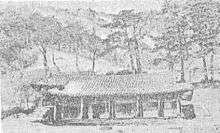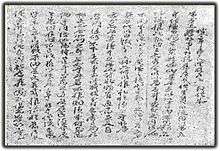Jaegaseung

A Buddhist temple built by Korean Jaegaseung minority

An example of oatmeal paper traditionally produced by Jaegaseung minority in Korea
Jaegaseung (Chosŏn'gŭl: 재가승, Japanese: 在家僧) were Jurchen people descendants who live in Korea. They formed villages of married lay monks.[1] They produced oatmeal paper and substituted their tax with it.[2] In modern times, Jaegaseung people were assimilated to Korean people by North Korea.[3] Their villages existed from the 18th century, when their descendants migrated from China, to the 1960s.[1]
Monastic identity of the lay monks was seen as antisocialist, and the villages have ceased to exist.[3]
Buddhist communities have been repressed by communist governments in Asian countries. The local communities had survived through colonial period without serious pressure from outside.[4]
See also
 Korea portal
Korea portal
References
- 1 2 "Los Angeles Lecture: Korea's Jōdōshinshū: Lay Monk Villages in Colonial Korea (25 April 2013)". April 25, 2013. Retrieved April 25, 2016.
- ↑ Dong-A ilbo, January 1, 1936, 56th page
- 1 2 Kim Hwansoo (2013). "'The Mystery of the Century:' Lay Buddhist Monk Villages (Chaegasŭngch'on) Near Korea's Northernmost Border, 1600s–1960" (PDF). Seoul Journal of Korean Studies. 26 (2): 297–299. Retrieved April 24, 2016.
- ↑ Frank Reynolds; Jason A. Carbine (2000). The Life of Buddhism. University of California Press. p. 16. ISBN 978-0-520-21105-6.
Further reading
| Wikimedia Commons has media related to Jaegaseung people. |
- Hwang Chol-san (1960). Hamgyŏng pukto pukpu san'gan purak (chaegasŭng purak) ŭi munhwa wa p'ungsŭp [Culture and customs of the mountain villages (lay monk villages) in far northern Hamgyong province]. OCLC 23977624.
- Kim Hwansoo (2013). "'The Mystery of the Century:' Lay Buddhist Monk Villages (Chaegasŭngch'on) Near Korea's Northernmost Border, 1600s–1960" (PDF). Seoul Journal of Korean Studies. 26 (2). Retrieved April 24, 2016.
This article is issued from Wikipedia - version of the 12/3/2016. The text is available under the Creative Commons Attribution/Share Alike but additional terms may apply for the media files.